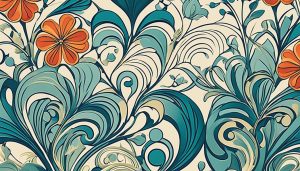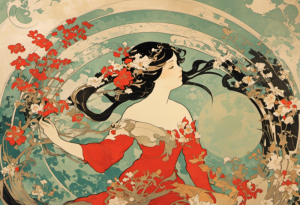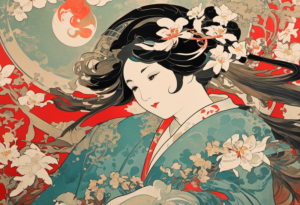Art Nouveau, also known as the “New Art,” emerged in the late 19th and early 20th century as a reaction to the traditional art forms of the time. It sought to break down the barriers between fine art and applied art, bringing beauty and functionality to all aspects of life. Art Nouveau had a profound impact on graphic design, influencing the aesthetic of modern visuals with its sensuous lines, Japanese-inspired flat perspectives, and emphasis on nature and sensual forms.

Key Takeaways:
- Art Nouveau emerged as a reaction to traditional art forms
- It broke the barriers between fine art and applied art
- Art Nouveau influenced the aesthetic of modern visuals in graphic design
- It incorporated sensuous lines and Japanese-inspired flat perspectives
- The emphasis on nature and sensual forms was a characteristic of Art Nouveau
The Origins of Art Nouveau
Art Nouveau, the first “modern” style, emerged during the turn of the century, reflecting the age of innovation, urbanization, and social changes. Rooted in the Arts & Crafts movement, which drew inspiration from Gothic-era crafts, Art Nouveau represented a shift towards the future, embracing nature, beauty, and optimism.
The Arts & Crafts movement sought to revive traditional craftsmanship in response to industrialization. However, Art Nouveau took a step further, breaking away from historical influences and embracing a new artistic direction. It was a response to the rapid urban expansion and technological advancements of the time, striving to create a harmonious fusion of art and life.
The turn of the century was characterized by a dynamic and transformative period of history. Rapid urbanization, increased international trade, and cultural exchange contributed to the development of a cosmopolitan environment. It was within this context that Art Nouveau emerged, drawing influence from various global sources to create a distinctive style.
As the world became more connected through international exhibitions and cultural exchanges, Art Nouveau artists and designers gained exposure to diverse artistic traditions and innovations. The movement found inspiration in the natural world, adapting organic forms and motifs into its designs. The turn of the century was a pivotal time, when traditional values met with modern ideals, giving rise to Art Nouveau.
One notable figure in the Art Nouveau movement was Alphonse Mucha, whose works exemplified the modern spirit and the influence of Japanese art. Mucha’s elegant and ornamental designs combined delicate lines, stylized organic forms, and nature motifs, drawing inspiration from the ukiyo-e prints of Japan. This fusion of Western and Eastern aesthetics became a defining characteristic of Art Nouveau.
Art Nouveau was not just confined to the realm of graphic design and visual arts. It permeated various disciplines, including architecture, furniture design, jewelry, and even fashion. The emphasis on flowing lines, asymmetrical compositions, and the synthesis of ornament and structure brought a sense of dynamism to these fields.
To better understand the origins of Art Nouveau, it is crucial to acknowledge its roots in the Arts & Crafts movement and its transformative response to the turn of the century’s societal, technological, and cultural changes. From there, the movement flourished, capturing the essence of a new era and establishing itself as a bold and influential artistic style.
The Circumstances that Gave Rise to Art Nouveau
Art Nouveau flourished during the late 19th and early 20th century, and its development was greatly influenced by international exhibitions held during this period. These exhibitions, such as the Paris World’s Fair of 1900, played a pivotal role in shaping and disseminating the Art Nouveau style across the globe.
The international exhibitions provided a platform for the exchange of ideas and information between different cultures, fostering a cosmopolitan environment that contributed to the popularity of Art Nouveau. Artists and designers associated with Art Nouveau saw themselves as part of a larger world, connected through trade fairs, magazines, and exhibitions that showcased their innovative ideas and creations.
The world trade facilitated by these exhibitions played a crucial role in spreading the Art Nouveau movement beyond its place of origin. The ideas and inspirations exchanged between artists from different countries fueled the growth and influence of Art Nouveau, making it a truly global phenomenon.
Art Nouveau’s international success can be attributed to its ability to capture the spirit of the cosmopolitan environment in which it thrived. The style’s fusion of influences from various cultures and its emphasis on modernity resonated with a society undergoing rapid changes due to urbanization, industrialization, and advancements in trade.
Through its harmonious integration of nature-inspired forms, ornamental motifs, and a unique sense of elegance, Art Nouveau captured the imagination of artists, designers, and the general public alike. Its distinctive aesthetic, with its sinuous lines and organic shapes, became emblematic of the era and continues to influence art and design to this day.
The Golden Age of the Poster
The Art Nouveau movement found a powerful medium for expression in the form of posters. Posters became instrumental in popularizing Art Nouveau and bringing its extravagant and flowing designs to a mass audience.
During this golden age of poster design, the Art Nouveau style flourished, captivating viewers with its captivating aesthetics and intricate details.

Posters became a platform for artistic expression, showcasing the unique visual language of Art Nouveau. They were used extensively to promote various products, exhibitions, events, and entertainment.
One significant development that contributed to the success of Art Nouveau posters was the advancement in printing technologies, particularly multiple-color lithography. This technique allowed for a wider range of tones and hues, bringing the intricate details and vibrant colors of Art Nouveau to life.
As a result, painters and artists were drawn to the medium, eager to experiment with the possibilities that multiple-color lithography offered. They embraced the poster as a canvas for their artistic visions, creating bold and captivating designs that reflected the essence of the Art Nouveau style.
Art Nouveau posters quickly gained popularity and were widely available. They adorned street corners, shop windows, and public spaces, captivating passersby with their intricate patterns, organic motifs, and sensuous lines.
This widespread availability and collectability of Art Nouveau posters further contributed to the proliferation and influence of the Art Nouveau movement as a whole.
Overall, the golden age of the poster in the Art Nouveau era was a testament to the marriage of artistic expression and functional design. It showcased the extravagant beauty of the Art Nouveau style and brought its visual language to the masses.
The Influence of Japanese Art on Art Nouveau
Japanese art, particularly ukiyo-e, played a significant role in shaping the development of Art Nouveau, leaving an indelible mark on the movement. The exquisite flat perspectives, meticulous use of space, and intricate decorative patterns found in Japanese art had a profound influence on the design principles and artistic expressions of Art Nouveau.
One notable artist who incorporated Japanese-inspired elements into his work was Alphonse Mucha. Known for his iconic posters and illustrations, Mucha masterfully blended the delicate lines, stylized organic forms, and nature motifs derived from Japanese art with the exuberance and elegance of Art Nouveau, creating a harmonious fusion that captivated the eyes and hearts of viewers.
The adoption of Japanese artistic techniques and aesthetics by Art Nouveau artists not only gave rise to a fresh and novel artistic style but also resulted in a progressive and distinctive visual language. Through this cross-cultural exchange between Japanese art and Art Nouveau, the movement embraced an innovative and expressive approach that embodied the spirit of the time.
The integration of Japanese art influences within Art Nouveau not only expanded the artistic horizons of the movement but also contributed to the broader appreciation and understanding of Japanese culture in the Western world. It bridged the gap between artistic traditions, fostering a new and influential artistic language that resonated globally.
Art Nouveau’s embrace of Japanese art and its incorporation of ukiyo-e aesthetics were instrumental in establishing a unique and captivating style that left an enduring impact on graphic design, architecture, and the decorative arts. The fusion of these two distinct artistic traditions resulted in the birth of a movement that reflected the zeitgeist of its time, and Art Nouveau stands today as a testament to the power of cross-cultural exchange and creative inspiration.

Art Nouveau in Architecture
Art Nouveau not only revolutionized graphic design but also made a significant impact on architecture. This architectural style, prevalent in the late 19th and early 20th centuries, sought a synthesis of ornament and structure, creating buildings that were not just functional but also visually captivating.
One of the defining characteristics of Art Nouveau architecture is the liberal combination of materials. Architects of this movement used a wide range of materials, including iron, glass, ceramics, and even exotic woods, to create intricate and expressive facades. The aim was to blur the boundaries between art and architecture, to create buildings that were works of art in themselves.
The synthesis of ornament and structure was another hallmark of Art Nouveau architecture. Elaborate decorative motifs, often inspired by natural forms such as vines, flowers, and flowing curves, were integrated into the overall structure of the building. These organic forms brought a sense of harmony and unity to the designs, creating a distinctive and cohesive aesthetic.
Art Nouveau architecture continues to leave its mark on cities worldwide, with notable examples including the works of Antoni Gaudí in Barcelona, Victor Horta in Brussels, and Hector Guimard in Paris. These buildings stand as testaments to the enduring legacy of Art Nouveau, showcasing its unique blend of artistic expression, innovative construction techniques, and a harmonious balance between ornamentation and structure.